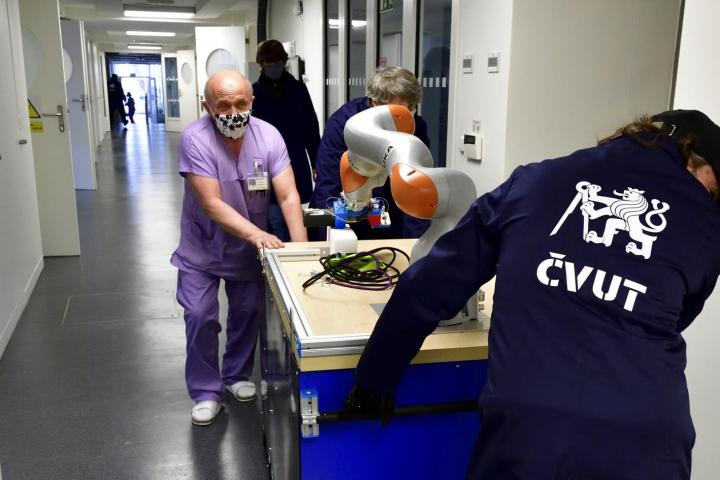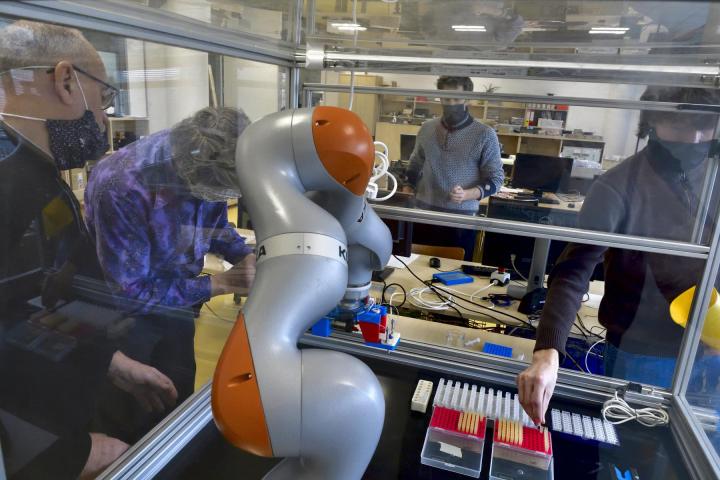The testing capacity of the Department of Clinical Microbiology of Na Bulovce Hospital has been an essential part of the testing process in the Czech Republic since the very beginning of the fight against COVID-19 caused by the SARS-CoV-2 coronavirus. By default, the laboratory tested dozens of samples a day. Now, with the same equipment, it's up to four hundred. Testing also involves manual pipetting of samples with various chemicals, which requires careful and focused work. With the current number of samples, the risk of error increases, and a robotic machine could help with this.
Early on, when just one of the first testing facilities, the Rector of the Czech Technical University, doc. Vojtěch Petráček and the Bulovka leadership selected a procedure where the robotic arm automatically performs key pipetting operations. The machine consists of a versatile robotic manipulator, a precision pump capable of replacing manual pipetting, and a precision built-in lab balance to verify after pipetting each sample that the expected amount of fluid has been transferred. 15 days passed from the first visit to the Bulovka Hospital until the machine was transported. “I am glad that another CTU program in the fight against coronavirus has reached its goal. The Pipette robot will facilitate, accelerate and refine the COVID19 PCR tests at Na Bulovce Hospital. I hope that he will succeed in his work and that he will be able to rest more in the lab and nurses, ”says CTU Rector doc. Vojtěch Petráček.
On Tuesday, 31 March, the researchers transported the robotic machine directly to Na Bulovce Hospital and put it together with the staff of the Clinical Microbiology Department into the hospital's operation. Borrowing for Bulovka is free of charge. In this way, the university and academic departments payback for the support they receive for their research. Without it, they would not be ready to help in the COVID-19 crisis.
Technical development was led by Ing. Vladimír Smutný, Ph.D., from CIIRC ČVUT with the assistance of RNDr. Lenka Richterová, Ph.D. from Clinical Microbiology Na Bulovce Hospital. Nuclear Chemist Ing. Daniel Seifert, Ph.D., working both at the Institute of Nuclear Physics AS CR and at CIIRC CTU, advised on how to teach the machine to pipette. The project was led by prof. Ing. Václav Hlaváč, CSc., From CIIRC ČVUT, who added to the project: “Development delayed that we needed to pass knowledge and experience of several fields, lend and buy necessary equipment such as a computer-controlled scale with microgram accuracy or a machine pipette. We have also encountered unexpected software complications in robot control due to packaging and errors in several software environments that we did not program. ”
“We are extremely pleased that this project will focus the assistance of academic workplaces on the laboratories on which the efforts to maximize the number of patients diagnosed on COVID-19 are based. In this situation, it is important that the automation of some steps releases the staff's hands, especially for the initial reception and preparation of patient samples for analysis, ”said RNDr. Lenka Richterová from dept. Clinical Microbiology Na Bulovce Hospital.
In addition to the semi-automatic method used in Bulovka and other hospitals, there are also fully automatic machines that can handle up to 1000 tests on COVID-19 per day. There are two of them in the Czech Republic. In addition, the research laboratories of the Academy of Sciences of the Czech Republic and universities strengthen the testing capacity with their automatic machines. Even so, in the COVID-19 crisis, the capacity of semi-automatic testing at Na Bulovce Hospital will be necessary.
Additional information:
Before COVID-19 Bulovka's laboratory staff tested dozens of patient samples for a variety of diseases, including viral, using universal laboratory equipment. The semi-automatic laboratory procedure of the universal laboratory involves manual pipetting, i.e. transferring a small amount of different chemicals from the test tube to the test tube. In the COVID-19 assay, mucosal swabs of the test subjects are screened for SARS-CoV-2 coronavirus RNA (ribonucleic acid). With the same equipment, the Bulovka laboratory now manages to test up to 400 samples per day for COVID-19. RNA from up to 96 samples is automatically isolated from patient swabs in a special machine. The next step is to multiply the molecules of RNA sought by the PCR (polymerase chain reaction) operation again in a machine capable of handling up to 96 samples at a time. As a result, it can be seen whether or not the SARS-CoV-2 RNA is present. After isolation of RNA, the laboratory workers at Bulovka manually pipet, i.e. transfer and mix patient RNA samples with detection chemicals. The laboratory workers must be very careful when working. They carry micro-liters of fluids in an infectious environment and must not be confused between test tubes of different patients. This is demanding both mentally and physically.
The pipetting robot is a machine composed of expensive universal parts that CIIRC CTU and the Institute of Nuclear Physics of the Academy of Sciences of the Czech Republic have for their research mainly from public sources, ie Czech and European money. The machine should work in Na Bulovce Hospital only during the COVID-19 crisis. Then it will be disassembled again and its most expensive parts (the robot, pump, the scale) will continue to serve in the original research.
Photography: Roman Sejkot, CIIRC ČVUT


